Microsoft has just released a revised version of the MS14-045 bulletin originally rolled out on August 12, this time trying to fix all the issues that this patch could cause, including BSODs on a number of Windows 7 installations.
As you might already know from previous coverage on this, some of the patches that were shipped to users on this month’s Update Tuesday cycle were causing quite a lot of issues, including BSODs during a cold boot.
Only little was known at the very beginning, but given the number of affected computers, the company decided to pull the updates and recommend users to remove them from their PCs until a fix is being provided.
That time has come and users can now download a new MS14-045 bulletin, and although it’s a revised version of the original KB2982791, it comes with a different name. KB2993651 is now the patch that should come to the rescue, with Microsoft recommending everyone experiencing issues with the previous update to remove it and then install this new patch.
“Microsoft strongly recommends that customers who have not uninstalled the 2982791 update do so prior to applying the 2993651 update. Customers do not need to uninstall the expired 2982791 update before applying the 2993651 update; however, Microsoft strongly recommends it. Customers who do not remove the expired update will retain a listing for 2982791 under installed updates in Control Panel,” the company says in a statement.
As Rod Trent of WindowsITPro reports, Tracey Pretorius, director of Microsoft Trustworthy Computing, says in a note that only a small number of computers are actually affected by this problem, which is a little surprising given the number of complaints that the company has received not only on its Community forums, but on websites from all over the world.
“This month we had our first roll out with additional non-security updates. A small number of customers experienced problems with a few of the updates. As soon as we became aware of some problems, we began a review and then immediately pulled the problematic updates, making these unavailable to download. We then began working on a plan to rerelease the affected updates,” Tracey Pretorius points out.
Although it’s hard to tell how many computers have actually been affected by these botched updates, it’s more important to know that a fixed bulletin is already up for grabs and you should be able to download it via Windows Update right away.

 14 DAY TRIAL //
14 DAY TRIAL //